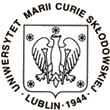

 |
 |
 |
|
Julian Srebrny
UW, Warsaw B(E2) and B(M1) transition probabilities as a test of supposed chiral band structure in 132LaA recent experiment [1] in the odd-odd 132La nucleus found a pair of bands built on the unique-parity h11/2 valence proton and neutron orbits. As interpreted by [1] within Core-Particle-Hole Coupling(CPHC) model the bands result from chiral symmetry breaking in the intrinsic frame of the triaxial nucleus. As an input to this model , the parametres of the triaxial core are fitted using properties of the even-even and odd-even neighbours. Therefore, our group has undertaken the DSAM measurements of nuclear level lifetimes in 131La and 132La (see report of E.Grodner). Experimental propertise of the h11/2 band in 131La are compared with theoretical prediction obtained in the framework of the Core-Quasi- Particle Coupling (CQPC) model and the Self-Consistent Total Routhian Surface calculation. Only CQPC model using phenomenological core is able to reproduce well B(E2) values for 131La. The same phenomenological core is used as an input to the CPHC model . The results of calculations are compared to experimental absolute B(M1) and B(E2) transition probabilities in 132La. The problem of chiral structures in 132La will be discussed. [1] K.Starosta et al. Phys. Rev. C65 (2002) 044328
| ||
Last modificated: 2003-09-22

